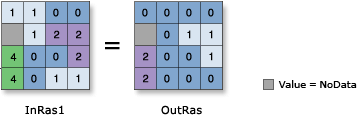Disponible con una licencia de Spatial Analyst.
Resumen
Performs a Bitwise Right Shift operation on the binary values of two input rasters.
Ilustración

Debate
Cuando se utiliza un operador con una entrada ráster, el resultado será un ráster. Sin embargo, si todas las entradas son números, entonces el resultado es un número.
Cuando se utilizan varios operadores en una expresión, no necesariamente se ejecutan en orden de izquierda a derecha. El operador con el valor de jerarquía más alta se ejecutará primero. Para obtener más información sobre la jerarquía del operador, consulte la tabla jerarquía del operador. Puede utilizar paréntesis para controlar el orden de ejecución.
The bitwise operators work on 32-bit integers.
If floating-point values are input, they are converted to integer values through truncation before the bitwise operation is performed. The output values are always integer.
Two inputs (rasters or numbers) are necessary for the bitwise operation to take place.
The order of input is relevant in the Bitwise Right Shift operation.
Binary values are stored in two's complement.
The leftmost bit position is reserved for the sign of the value (positive or negative). If the integer is positive, the bit position is zero; if it's negative, the bit position is one.
The Bitwise Right Shift operation does no wrapping of bits. The rightmost bit is dropped.
Another way to perform the Bitwise Right Shift operation is a >>= b which is an alternative way to write a = a >> b.
Sintaxis
in_raster_or_constant1 >> in_raster_or_constant2
| Operando | Explicación | Tipo de datos |
in_raster_or_constant1 | El ráster de entrada en el cual se realiza el cambio. La entrada puede ser entera o punto flotante, pero los valores de puntos flotantes se convertirán en enteros antes de que se realice la operación de bit a bit. If the first input is a raster and the second is a scalar, an output raster is created with each input raster value being bitwise right shifted by the scalar value. | Raster Layer | Constant |
in_raster_or_constant2 | The input raster defining the number of positions to shift the bits. La entrada puede ser entera o punto flotante, pero los valores de puntos flotantes se convertirán en enteros antes de que se realice la operación de bit a bit. If the first input is a scalar and the second is a raster, an output raster is created with each input raster value defining the bitwise right shift for the scalar value. | Raster Layer | Constant |
Valor de retorno
| Nombre | Explicación | Tipo de datos |
| out_raster | El objeto ráster de salida. The cell values are the result of a Bitwise Right Shift operation on the inputs. | Raster |
Muestra de código
This sample performs a Bitwise Right Shift operation on two input rasters.
import arcpy
from arcpy import env
from arcpy.sa import *
env.workspace = "C:/sapyexamples/data"
outBitwiseRShift = Raster("degs") >> Raster("negs")
outBitwiseRShift.save("C:/sapyexamples/output/outbitrs")This sample performs a Bitwise Right Shift operation on two input rasters.
# Name: Op_BitwiseRightShift_Ex_02.py
# Description: Performs a Bitwise Right Shift operation on the binary
# values of two input rasters
# Requirements: Spatial Analyst Extension
# Import system modules
import arcpy
from arcpy import env
from arcpy.sa import *
# Set environment settings
env.workspace = "C:/sapyexamples/data"
# Set local variables
inRaster1 = Raster("degs")
inRaster2 = Raster("negs")
# Check out the ArcGIS Spatial Analyst extension license
arcpy.CheckOutExtension("Spatial")
# Execute BitwiseRightShift
outBitwiseRShift = inRaster1 >> inRaster2
# Save the output
outBitwiseRShift.save("C:/sapyexamples/output/outbitrshift.img")